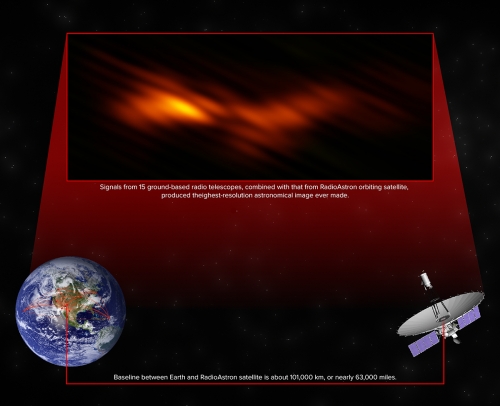Centauri Dreams
Imagining and Planning Interstellar Exploration
A New Look at the ‘Big Whack’
Somewhere a decade or so back in these pages a Centauri Dreams commenter described the event that formed our Moon as ‘the big whack.’ Although I hadn’t run across it before, the phrase turns out to have been common parlance for what is now thought to be a massive collision between the Earth and an early planetesimal. But whatever the case, we know a bit more about the cataclysm thanks to new work out of UCLA, as reported in the journal Science.
The impactor, which struck about 4.5 billion years ago, is commonly called Theia. So how do we analyze such a remote event? The key, as discussed in this UCLA news release, is oxygen, which makes up 90 percent of the volume of lunar rocks the team of geochemists studied, and 50 percent of their weight. Usefully, oxygen can manifest itself in various isotopes, the most common on Earth being O-16, meaning each atom holds eight protons and eight neutrons.

Image: Light image of a lunar rock from the Apollo 17 mission. Credit: NASA.
Heavier isotopes like O-17 (with one extra neutron) and O-18 (with two) occur, though on Earth 99.9 percent of the oxygen is O-16. But each of the planetary bodies in our Solar System has a unique ratio of O-17 to O-18, making for a characteristic signature.
To analyze these ratios, the team studied seven moon rocks from Apollo missions 12, 15 and 17, while also working with five volcanic rocks from Hawaii and one from Arizona. Led by UCLA’s Edward Young, the team found no difference between the Earth’s oxygen isotopes and those of the Moon. This contradicts a 2014 study from Germany (also published in Science) that argued for a distinct ratio of oxygen isotopes on the Moon as opposed to the Earth.
Theia was probably a growing object that would have become a planet in its own right. It may have been as large as the Earth, though some believe it was closer in size to Mars. If the UCLA work is correct, the oxygen isotope data tell us that the collision would have been head-on, for if it had been a glancing blow, the great bulk of the Moon would have been made up of Theia, and would thus have shown different oxygen isotope ratios than the Earth’s. A head-on collision should have produced a similar chemical composition on both Earth and Moon.
“Theia was thoroughly mixed into both the Earth and the moon, and evenly dispersed between them,” Young said. “This explains why we don’t see a different signature of Theia in the moon versus the Earth.”
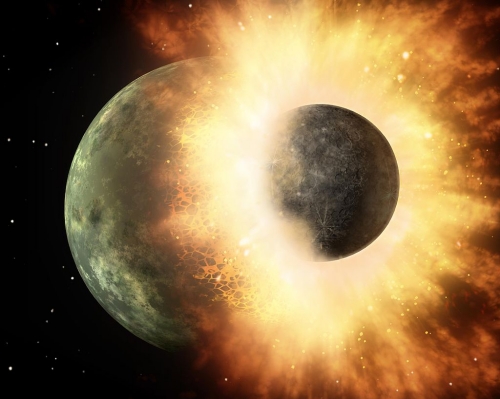
Image: Artist’s depiction of a collision between two planetary bodies. Such an impact between the Earth and a Mars-sized object likely formed the Moon. Credit: NASA/JPL-Caltech.
Thus a head-on collision, as theorized in 2012 by Matija ?uk (SETI Institute) and Sarah Stewart (UC-Davis), and also by Robin Canup (SwRI) in the same year, now has more weight. The catastrophic impact’s possible role in removing any water found in the early Earth is not known, though water from small asteroid and comet impacts would eventually be plentifully available.
The paper is Young et al., “Oxygen isotopic evidence for vigorous mixing during the Moon-forming giant impact,” Science Vol. 351, Issue 6272 (2016), pp. 493-496 (abstract). For the German work in 2014, see D. Herwartz, A. Pack, B. Friedrichs, A. Bischoff, Science 344, 1146–1150 (2014).

A Telescope Eight Times the Diameter of Earth
If you’re looking for detailed imagery of a distant astronomical object, VLBI (Very Long Baseline Interferometry) can deliver the goods. As witness the image below, which the National Radio Astronomy Observatory (NRAO) is calling “the highest resolution astronomical image ever made.” Here we see radio emission from a jet of particles moving close to the speed of light. The particles are being accelerated by a supermassive black hole at the core of the galaxy BL Lacertae, a highly variable ‘active galaxy’ some 900 million light years from the Earth.
Image (click to enlarge): Signals from 15 ground-based radio telescopes, combined with data from the RadioAstron orbiting satellite, produced the highest resolution astronomical image ever made. Credit: Gomez, et al., Bill Saxton, NRAO/AUI/NSF.
What fascinates me about this work is the technique. Very Long Baseline Interferometry works by collecting a signal at multiple radio telescopes, the distance between them being calculated from the different arrival times of the radio signal at the different installations. The calculations are made using a local atomic clock, with the data correlated with data from other antennae in the array to produce an image.
The upshot is that VLBI methods allow us to work with an emulated ‘telescope’ that has a size equal to the maximum separation between the constituent telescopes in the array. Conventional interferometry does much the same thing, but VLBI does not demand the physical coaxial cable or optical fiber connections of the former, allowing for greater distances between the telescopes.
In this case, we have fifteen ground-based radio telescopes combining their data with signals from the Spektr-R satellite of the RadioAstron mission, a Russian spacecraft with a 10-meter radio telescope. Launched in July of 2011, Spektr-R can work with large Earth-based radio telescopes to form interferometric baselines that extend up to 350,000 kilometers. In this case, working with radio telescopes in Europe and nine antennae from the Very Long Baseline Array in the US, the image produced was one with the resolving power of a telescope 100,000 kilometers wide, roughly eight times the diameter of the Earth. From the paper:
RadioAstron provides the first true full-polarization capabilities for space VLBI observations on baselines longer than the Earth’s diameter, opening the possibility to achieve unprecedentedly high angular resolution in astronomical imaging. In this paper we present the first polarimetric space VLBI observations at 22 GHz, obtained as part of our RadioAstron KSP [Key Science Program] designed to probe the innermost regions of AGN and their magnetic fields in the vicinity of the central black hole.
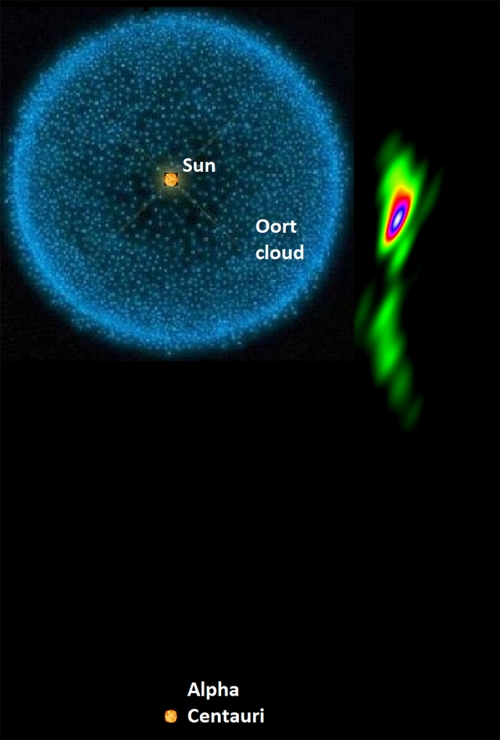
Credit: Artwork by Jon Lomberg.
Above we see the jet from BL Lacertae fitted within a diagram of our local interstellar neighborhood. Notice that if we take the Oort Cloud as the outer perimeter of our Solar System, the jet just about fits within the system or, if we imagine one end of the jet at the outer edge of the Oort, the jet would extend almost to the Alpha Centauri stars. The detail we can see here is roughly equivalent to seeing a 50-cent coin on the Moon. The image elongation results from the greater resolving power in the direction of the satellite as compared to the ground telescopes, with resolution in the orthogonal direction being exaggerated to compensate for the effect.
As for BL Lacertae itself, it was originally thought to be a variable star within the Milky Way after its discovery in 1929, but was later identified as a bright radio source. Subsequent redshift measurements showed a recession velocity of 21,000 kilometers per second, implying a distance of 900 million light years. BL Lacertae is considered an AGN, or active galactic nucleus galaxy, the latter being a designation for a galaxy with a compact region at its center that has a much higher than normal luminosity over at least part of the electromagnetic spectrum.
The paper is Gómez et al., “Probing the innermost regions of AGN jets and their magnetic fields with RadioAstron. I. Imaging BL Lacertae at 21 microarcsecond resolution,” Astrophysical Journal Vol. 817, No. 2 (26 January 2016). Preprint available.

New Pluto Imagery
Newly interpreted data from the New Horizons spacecraft tells us that Pluto has more water ice on its surface than we once thought. The image below tells the tale, a false-color view derived from observations by the Ralph/Linear Etalon Imaging Spectral Array (LEISA) instrument. Here we’re at infrared wavelengths and can see areas showing the spectral signature of water ice. Note the sharp contrast between the left and right sides of the image below.

Image: This false-color image is derived from observations in infrared light by the Ralph/Linear Etalon Imaging Spectral Array (LEISA) instrument. It is based on two LEISA scans of Pluto obtained on July 14, 2015, from a range of about 108,000 kilometers. Credit: NASA/Johns Hopkins University Applied Physics Laboratory/Southwest Research Institute.
The two scans, as this JHU/APL news release explains, were taken about fifteen minutes apart and merged into a ‘data cube’ — a three-dimensional array covering the hemisphere New Horizons could see during the flyby last summer, where an image of Pluto is formed at each wavelength of light to which LEISA is sensitive. The map on the left was made by comparing LEISA spectra with a pure water ice template spectrum. When using this technique, methane ice can easily mask the spectral signature of water ice.
The result: A map sensitive only to those areas particularly rich in water or depleted in methane. On the right is an image that more fully models the various ices, showing the true extent of water ice. Interestingly, we still see little water ice in Sputnik Planum (left of Pluto’s ‘heart’) and Lowell Regio (far north on the encounter hemisphere). This would indicate that the ice ‘bedrock’ is buried beneath a thick blanket of ices like methane, nitrogen and carbon monoxide.
Infrared Views of Pluto’s Atmosphere
We’re also working with data from the LEISA instrument in the image below. Captured on July 14, 2015 at a distance of 180,000 kilometers, the image covers the full spectral range (1.25 to 2.5 microns) of the instrument. North in the image is at about the 10 o’clock position.
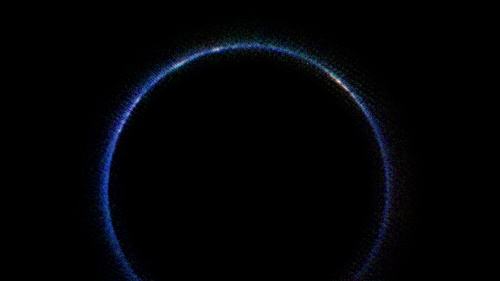
Image: This image from NASA’s New Horizons spacecraft is the first look at Pluto’s atmosphere in infrared wavelengths, and the first image of the atmosphere made with data from the New Horizons Ralph/Linear Etalon Imaging Spectral Array (LEISA) instrument. Credit: NASA/Johns Hopkins University Applied Physics Laboratory/Southwest Research Institute.
The blue ring we see in the image is the result of sunlight scattering off haze, as JHU/APL explains in this second news release:
…scientists believe the haze is a photochemical smog resulting from the action of sunlight on methane and other molecules, producing a complex mixture of hydrocarbons such as acetylene and ethylene. These hydrocarbons accumulate into small particles – a fraction of a micrometer in size – which scatter sunlight to make the blue haze.
Infrared images like these can be combined with images made at shorter wavelengths to help researchers understand the size distribution of the particles. The New Horizons team tells us that the white patches that show up around Pluto’s limb are where sunlight is bouncing off more reflective areas on Pluto’s surface. The largest of these would be the the area now being called Cthulhu Regio (the H.P. Lovecraft reference still delights me). We have much more data ahead from New Horizons, and can expect fuller views of the atmosphere in the course of the year.
A Change at the Top

I also want to note that New Horizons has a new project manager. Helene Winters takes over the role from Glen Fountain, who had been project manager since early 2004. Winters served as project manager for the Mini-RF lunar radar instrument, and most recently as project manager for the MESSENGER mission, which orbited Mercury for four years before a planned dive into Mercury’s surface last April. Winters will also continue as MESSENGER project manager through that mission’s closeout stages. Says principal investigator Alan Stern:
“Over the past 15 years New Horizons has had two of the finest project managers in the space business, the late Tom Coughlin, who helped conceive the mission, and the legendary Glen Fountain, who built New Horizons and flew us to Pluto. Helene Winters, from a new generation and with incredible experience behind her, is going to set new milestones flying the spacecraft farther, hopefully to the first ever flyby of a Kuiper Belt object and onward toward the edge of our planetary system!”
The outer system, as we’ve learned in recent days, is getting more and more interesting. As we look forward to the New Horizons KBO flyby in January of 2019, we should also keep pondering the kind of follow-up mission that New Horizons merits. We need observations of the local interstellar medium beyond the heliosphere and we also have a wide range of Kuiper Belt targets, not to mention the eventual goal of reaching the Sun’s gravity focus at 550 AU. Tune up the technologies to reach these distances and, if it’s really out there, we might just visit the hypothesized Planet Nine.

Starship Thinking
It’s been awhile since I’ve seen Ian Crawford (Birkbeck College, London) — I think we last talked at one of the 100 Year Starship events — but I’m pleased to see his latest popular essay How to build a starship – and why we should start thinking about it now. A professor of planetary sciences and advocate of manned space exploration here in the Solar System, Crawford takes on the necessary task of acquainting a larger audience with something Robert Forward put forth as a maxim: ‘Starflight is difficult and expensive, but not impossible.’
Following decades of work on beamed sail technologies, antimatter and space tethers, Forward wrote that line in 1996, but it summed up statements he had been making for decades. Gregory Matloff and Eugene Mallove would echo him in their Starflight Handbook (Wiley, 1989), with an emphasis on the ‘difficult’ aspect of the journey: “Starflight is not just very hard, it is very, very, very hard!” So I guess we could say starflight is hard3. Matloff, who knew Forward well, has never entertained any illusions about the magnitude of the task.
Neither has Ian Crawford, who wants to keep Forward’s injunction out there. If there were some aspect of known physics that would have to be contradicted to make star travel possible, we would look at the matter differently. But instead we find vast problems of engineering and the need to overcome huge distances with craft that can operate for decades and perhaps centuries, returning data at the end of the journey. Crawford’s work has always engaged me because of his inherent optimism, and here he makes the case that ongoing work in areas like nanotechnology may get us to at least small, robotic space probes sooner than we think.
Igniting the Effort

The driver for such an attempt, in my view, would be the discovery of a nearby world in the habitable zone of its star. But it would take more than its presence. We would also have to have data from future space missions (and the next generation of ground-based telescopes) that showed biosignatures in the planet’s atmosphere. If we could make a strong case for there being a living world around, say, a planet of Proxima Centauri, we would surely want to make closeup investigations to learn about how evolution has played out on such a world.
Crawford gives a nod to the five craft that are currently on track to leave our Solar System altogether — the two Pioneers, the two Voyagers, and New Horizons. All will fall silent long before they approach another star, though I have been trying to resurrect a Sagan idea from the early Voyager days that one or both craft could have their trajectories adjusted with a final, tank-emptying burn to make a stellar encounter more likely in tens of thousands of years. If this sounds quixotic, it’s meant to be. It would be a purely symbolic statement of what our species can do (and as for the more practical details, I’ll turn you to my essay Voyager to a Star).
Image: Professor Ian Crawford doing astrobiological fieldwork on the Kverkfjoll volcano, Iceland. Credit: Ian Crawford.
But actual scientific return is another matter. It will require not ‘new physics’ but an expansion of our existing capabilities into areas of long-lifetime instrumentation and advanced laser communications, not to mention propulsion technologies like beamed power, fusion or more exotic methods. We’ve investigated the latter in the pages of Centauri Dreams, and Crawford has written them up in a 2010 paper called “‘A Comment on ‘The Far Future of Exoplanet Direct Characterization’ – The case for Interstellar Space Probes” (citation below).
Over the years, scientists have worked out a number of propulsion designs that might be able to accelerate space vehicles to these velocities… While many of these designs would be difficult to construct today, as nanotechnology progresses and scientific payloads can be made ever smaller and lighter, the energies required to accelerate them to the required velocities will decrease.
So we can talk about nuclear possibilities. Here I lean much more strongly toward nuclear pulse methods (think Project Orion) than fusion, though it will be interesting to see what the Icarus Interstellar team comes up with as it continues to refine the 1970’s-era Project Daedalus starship, which itself was based on a still-unavailable method called inertial confinement fusion, as studied by Friedwardt Winterberg. Using the energy released by either splitting or fusing atomic nuclei has long been studied by interstellar theorists, as has the much more powerful annihilation of matter and antimatter, though this is plagued by production problems (we can’t produce remotely enough) and certainly by storage issues for large amounts of antimatter.
Everything from interstellar ramjets to beamed laser or microwave sails is in the database here. Of the latter, Crawford says this:
Spacecraft using “light-sails” pushed by lasers based in the solar system are also a possibility. However, for scientifically useful payloads this would probably require lasers concentrating more power than the current electrical generating capacity of the entire world. We would probably need to construct vast solar arrays in space to gather the necessary energy from the sun to power these lasers.
Absolutely so, making the construction of a space-based infrastructure here in the Solar System a prerequisite for sending our first true interstellar probes. As Crawford notes, we are talking about systems far too large and certainly too power-laden to contemplate launching from Earth. They’ll be constructed in space as an outgrowth of this infrastructure. “This means,” Crawford adds, “that interstellar space travel is only likely to become practical once humanity has become a spacefaring species.”
Incremental Growth into Space
So there is a path for development here that acknowledges our current inability to send craft with data return capability to nearby stars, and addresses the problem by moving step by step to gradually acquire the needed expertise. This takes us to the Moon and Mars and beyond:
We need to progressively move on from the International Space Station to building outposts and colonies on the Moon and Mars (as already envisaged in the Global Exploration Roadmap). We then need to begin mining asteroids for raw materials. Then, perhaps sometime in the middle of the 22nd century, we may be prepared for the great leap across interstellar space and reap the scientific and cultural rewards that will result.

Image: To make the first interstellar mission a reality, we’ll need to move step by step from current space technologies toward a true infrastructure moving well beyond Earth orbit. Credit: NASA.
Crawford’s is a vision that places interstellar efforts into a broad context, one that will have to build the necessary levels of public support, and of course it will also have to show short-term value by way of scientific return and, in the case of asteroid mining, the necessary raw materials for growing the infrastructure. I think the middle of the 22nd Century is a highly optimistic goal, but it’s one worth working toward, and we can’t know what kind of breakthroughs may occur along the way (again, my money is on nanotech) to make the process quicker and more effective. Star travel may be hard3, but what else would we expect when it comes to translating a great imaginative venture into a mission that will someday fly?
Ian Crawford’s paper on interstellar propulsion technologies is “A Comment on “The Far Future of Exoplanet Direct Characterization”—The Case for Interstellar Space Probes,” Astrobiology 10(8) (November, 2010), pp. 853-856 (abstract).

Bradley Schaefer: A Response to Michael Hippke
The question of a gradual dimming of KIC 8462852 continues to make waves, the most recent response being Michael Hippke’s preprint on the arXiv site, discussed in the post immediately below. Bradley Schaefer (Lousiana State University), who published his work on the dimming he found in now digitized photographs in the archives of Harvard College Observatory, disagrees strongly with Hippke’s findings and is concerned that the paper impugns the solid work being performed by DASCH (Digital Access to a Sky Century@Harvard). Below is Dr. Schaefer’s response with details on the astrophotographic photometry at the heart of the issue.
by Bradley E. Schaefer

A few hours ago, Michael Hippke posted a manuscript to arXiv (http://arxiv.org/abs/1601.07314), and submitted the same manuscript to the Astrophysical Journal Letters (ApJLett). This manuscript claims to have found that the DASCH data produces light curves with secular trends (both systematic dimmings and brightenings) over the century-long records. This same DASCH data (from the collection of archival sky photographs now at Harvard Observatory) was used to recognize a dimming of KIC 8462852 (a.k.a. ‘Tabby’s Star’ or the ‘WTF star’) at an average rate of 0.165±0.013 magnitudes per century from 1890 to 1989.
This dimming from the DASCH data is just a long-time scale version of the dimming also seen with the Kepler spacecraft, and these dimmings are still a high mystery and a perplexing problem. Hippke is taking his claimed result (that the majority of DASCH light curves have major and widespread calibration errors resulting in apparent secular trends) as then implying that KIC 8462852 does not have any secular trend. This claim is easily proved wrong.
Hippke made two major errors, both of which are beginner’s mistakes, and both of which will erroneously produce apparent dimmings and brightenings when none exist. First, Hippke explicitly includes red-sensitive and yellow-sensitive photographs together with the blue-sensitive photographs. The different colors will produce systematically different brightnesses (magnitudes). The trouble is further that the red and yellow photographs are predominantly at late times in the century-long light curve (in the 1970s and 1980s), so the inclusion of many magnitudes that are systematically high or low only at the end of the century will artificially make the star appear to brighten or dim over the century.
Second, Hippke explicitly includes magnitudes from photographs with known and recognized defects. The Harvard photographs are not perfect, with some having long-trailed images, some being double exposures with stars overlapping, and some having various plate defects where the emulsion is nicked or such. The DASCH scanning and software has a robust means of identifying problem photographs, and these are objective measures independent of the magnitude. These known-poor-quality magnitudes should not be used for any sensitive purposes. Colloquially put, these are ‘garbage’. Hippke keeps all the many good DASCH magnitudes and he also adds in the garbage magnitudes, so his final light curves have many points that are systematically skewed.
The frequency of the poor-quality magnitudes varies over time, usually with more early-on during the century. And the erroneous magnitudes are variously systematically brighter or dimmer, also varying over the century. The result of Hippke’s good+garbage light curves is that the garbage points tilt the light curve by a bit. This is seen when I take all of Hippke’s same stars and data and go from his sloped light curves (including his garbage points) to flat light curves (with only the good points). The bottom line is that Hippke’s second big mistake was to include the poor-quality photographs. Garbage-in, garbage-out.
So we understand why Hippke’s secular trends are wrong. But we already knew this very well anyway. The reason is that the DASCH people have already measured many (likely up around the millions) of light curves for single main sequence stars (i.e., stars that really should be perfectly constant) and found that their light curves are actually very flat. This is in stunning contradiction to the claims of Hippke that the majority show big secular trends.
Hippke’s paper has a title of “KIC 8462852 Did Likely Not Fade During the Last 100 Years”, yet his paper never discusses or analyses any data from KIC 8462852. One reason is perhaps that he cannot get around the flatness of the five check star light curves. That is, these five stars always appear within 3 millimeters of Tabby’s Star on these 10″x8″ phootgraphs, these stars are all of similar brightness as Tabby’s Star, and they all have similar color as Tabby’s Star.
If there were any systematic problems for the DASCH data with Tabby’s star, then we should see the exact same dimming trend in the check stars as is seen for Tabby’s Star. But we do not. These ‘check stars’ serve as the classic control study in science. They serve as proof that neither the check stars nor Tabby’s Star have any substantial systematic problem. They serve as proof that Hippke’s title is wrong.
Hippke submitted his draft manuscript to ApJLett, to arXiv and to reporters even before he had any checks with experts on archival sky photographs. For example, I first read his email just about the time that he was submitting his manuscript. He did not contact any of the DASCH people, despite them being the target of his attack. Indeed, he has not talked with anyone who has any experience with or knowledge of any archival photographs. This topic has a lot of detail and many quirks, but Hippke apparently did not have the realization or the will to check out his claims. And, in an email from Hippke from early this morning, he explicitly labelled himself as “a novice” for this technical topic. So he is a novice working without bothering to check with anyone knowledgeable. As such, it is not surprising that he made beginner’s blunders.
A broader problem is now that DASCH has the publicly-stated claim that it has major, widespread, persistent calibration and measurement errors. In knowledeable circles, Hippke’s paper won’t come to anything. But these circles are not large, because few people really understand the working of DASCH or plate photometry.
So most people will simply look at the paper’s conclusions, not recognize the horrible beginner’s blunders that create the false conclusion, and only come away thinking that the DASCH light curves are “wrong” or at least “questionable”. Public perceptions do matter for many aspects. Most important for DASCH is their future success rate in funding proposals, the reception of all future papers relating to DASCH, and the future useage of the DASCH data.
Perhaps from a journalistic point of view, any ‘stirring of the pot’ is good copy. But from the point of view of science and knowledge, putting up unchecked and false claims is bad all the way around. Science has a great strength of being error-correcting, with the normal procedure now for the DASCH people to put out a full formal refutation of Hippke’s claims, and such will appear in many months. But with the one-day turn-around of arXiv and with fast journalist response, there will be many months where the reputation of DASCH is maligned. So Hippke’s choice of running to reporters before the paper appeared publicly, and disdaining any experienced advice despite being a self-proclaimed “novice”, is not good science.
——-
For more on this controversy, see KIC 8462852: Where Are We After Eight Months?, Michael Hippke’s follow-up.

KIC 8462852: No Dimming After All?
As if the Kepler star KIC 8462852 weren’t interesting enough, Bradley Schaefer (Louisiana State) added to the controversy when he discovered what appeared to be a steady dimming of the star over the past century. Schaefer called the result “completely unprecedented for any F-type main sequence star,” and given the discussion about KIC 8462852 as a SETI target, this raised the stakes. Something just as odd as the object’s strange lightcurves was going on here, and it seemed natural to think that the dimming and the lightcurves were related.
But Michael Hippke now begs to disagree. An old friend of Centauri Dreams (see, for example, his Exomoons: A Data Search for the Orbital Sampling Effect and the Scatter Peak), Hippke takes a close look at Schaefer’s work and reaches a different conclusion. As he sees it, the ‘dimming’ of up 0.165 ± 0.013 magnitudes per century in this F3 star may actually be the result of imperfect calibration on the Harvard plates. In other words, while the lightcurve anomalies remain, the dimming may well be a data artifact rather than an astrophysical enigma.
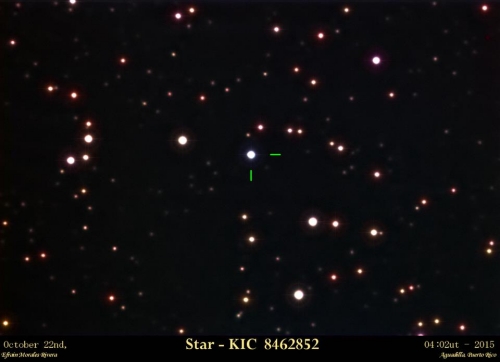
Image: KIC 8462852 as photographed from Aguadilla, Puerto Rico by Efraín Morales, of the Astronomical Society of the Caribbean (SAC).
First, though, a word about Bradley Schaefer’s work, about which Hippke says “Schaefer had the excellent idea to look into the old plate archives. To solve this mystery, we need all the information we can get, and Schaefer did very careful and high-quality work.”
This parallels comments I’ve heard from other professionals, who praise the quality of Schaefer’s analysis. Submitted to Astrophysical Journal Letters, the Hippke paper looks to contrast the ‘dimming’ of KIC 8462852 with an analysis of other F-type main sequence stars from the same dataset. Along the way, Hippke double-checks Schaefer and finds sound work:
Although the process of data cleansing and binning involves arbitrary choices, we have reproduced this part of the analysis for all variants with virtually identical results. It is therefore important to note that the method and results in Schaefer (2016) appear to be adequately careful and accurate. In the following, we will thus concentrate solely on the interpretation of his result – whether the dimming is “unprecedented”.
Take away its odd lightcurves and KIC 8462852 appears to be a relatively normal star. Thus Hippke’s criteria for study are F-stars from the Kepler field of view, from which photometry is studied for the 3 most quiet F-dwarfs and 25 bright F-dwarfs in the Harvard DASCH (Digital Access to a Sky Century @Harvard) archive. Trends in the data may not, Hippke believes, be slow drifts but ‘structural breaks’ — in other words, changes caused by abrupt changes in technology or calibration techniques. Evidence for this occurs not only for KIC 8462852 but also for KIC 7180968, indicating we are dealing with a phenomenon not isolated to KIC 8462852.
From the paper:
The significant trends (and/or structural breaks) found in 18 of 28 comparison stars support the interpretation that the dimming of KIC 8462852 is not extraordinary. A careful analysis of each dataset is time-consuming, which is why we have not performed this analysis for hundreds of stars. In case of further doubt on the significance of such trends, the analysis presented could simply be expanded to more stars.
This would make an astrophysical interpretation of the ‘dimming’ unlikely because it would require that a number of main-sequence F-dwarfs fluctuate by 10% or more over the course of a century. “It seems more likely,” writes Hippke, “that the change of emulsions, errors in calibration etc. cause these trends.” In an email just received, Hippke notes of Schaefer’s work that “It might just be that his check stars were unusually stable, which obfuscated existing trends in the data.”
Thus the paper favors the notion that changes in technology and imperfect calibration — quality issues in the dataset itself — explain what otherwise appears to be long-term dimming of KIC 8462852. This leaves us, as the author notes, with the short-term dimmings found in KIC 8462852’s lightcurves, a problem that the question of century-long dimming does not address.
What can be done to investigate the dimming issue further? Hippke’s email suggests that other data, particularly plates from the Sonneberg Observatory in Germany, will be useful for comparison. “Unfortunately, these plates are not available online and have only partially been scanned, so checking these data might take several months.”
The paper is Hippke, “KIC 8462852 did likely not fade during the last 100 years,” submitted to the Astrophysical Journal Letters (preprint). Bradley Schaefer strongly disputes Hippke’s work, so we haven’t heard the end of this.

